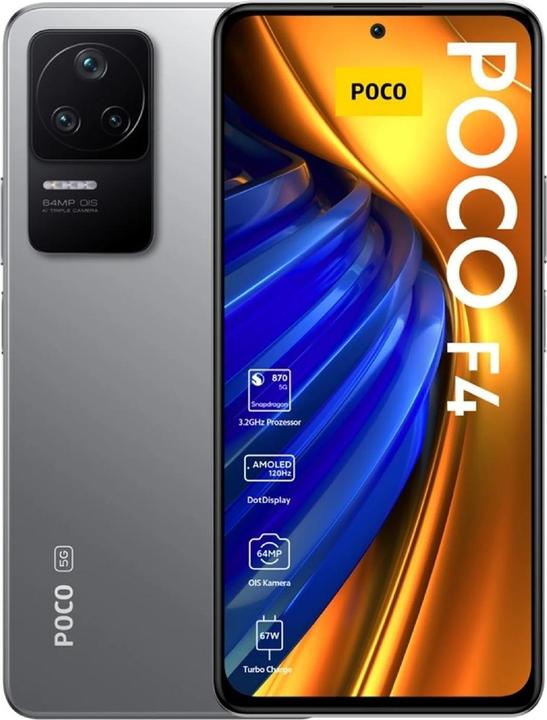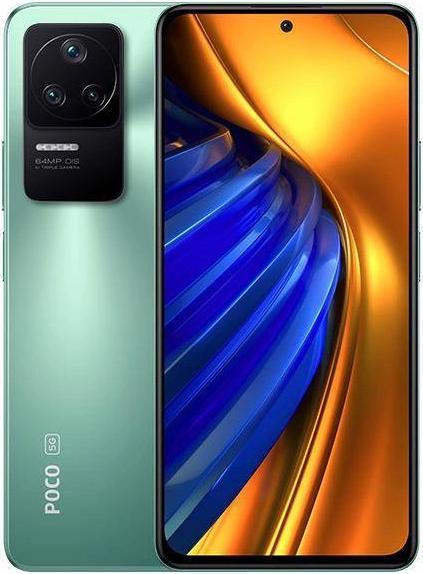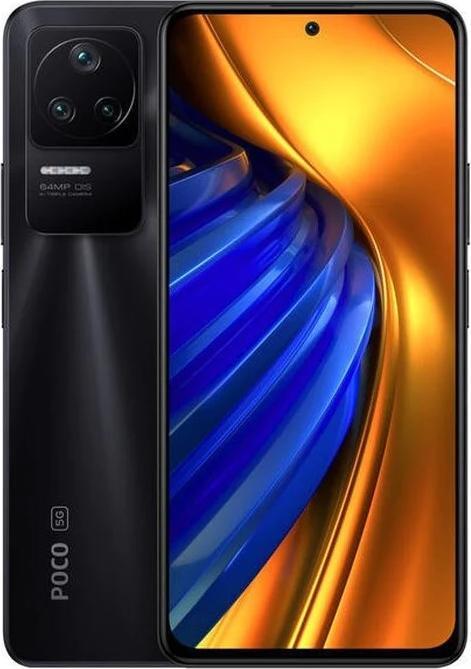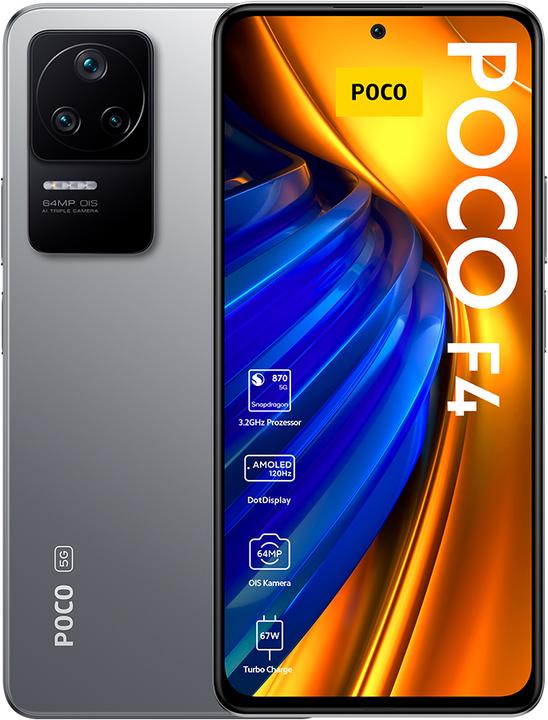

Poco F4 in the test: Why should we spend more money on a mobile phone?
The Poco F4 has big shoes to fill. After all, the Poco F3 was one of the most popular mid-range smartphones from Xiaomi in 2021. Can the Poco F4 follow suit and perhaps even raise the bar a little higher?
This is an article by our content partner "Nextpit". Here you can find the original article by Carsten Drees.
Pro
- Crackling, bright AMOLED display with 120 Hz
- Good build quality
- Great main camera
- Strong performance
- Quick charging
- Charger included
Contra
- Superfluous 2MP macro camera
- Bloatware and advertising
- no IP certification
- no microSD
- No headphone jack
- no wireless charging
Xiaomi Poco F4: Price and Availability
The Poco F4 was launched alongside the Poco X4 GT (review) in June. There are two versions to choose between: The model with 128 GB of storage and 6 GB of RAM is available for 399.90 euros, while the large model we tested with 8 GB of RAM and 256 GB of storage costs 449.90 euros.
You can choose one of three colours: Moonlight Silver, Night Black and Nebula Green.
Xiaomi Poco F4: Design and workmanship
Happily, Xiaomi does not only reserve high-quality workmanship for the upper class. With its angular design, the Poco F4 looks very valuable. An IP certification is missing, however - this saves Xiaomi the cost of licensing.
Liked:
- High-quality workmanship
- pleasantly slim design
- fast fingerprint sensor
Don't like:
- Back side a fingerprint magnet
- no IP certification
- no microSD port
- no 3.5 mm jack connector
The Poco F4 comes in three colours: Moonlight Silver, Night Black and Nebula Green. With the other two colours, it might not matter much, but with our black test device, my fingerprints quickly gather for a funny get-together. Apart from that, I really like the design of the device.

The flat design makes the device more angular; at 7.7 mm, it is the thinnest Poco smartphone to date. This makes it a little less comfortable to hold in my opinion and thanks to the camera elevation, it tilts a little on the table. In the front, Xiaomi offers Corning Gorilla Glass 5 and the back is also made of glass. The frame, on the other hand, is made of plastic and houses excellently processed buttons with good pressure points.
As is so often the case, Xiaomi / Poco does not obtain an IP certificate. Nevertheless, the device should be splash-proof. There are no buttons at all on the left side, the volume rocker is on the top right and the power button is below it, which also houses the fingerprint sensor.

By the way, this triggers super fast. That's great when I want to unlock the smartphone quickly. But it's not so great when I want to put it in my pocket and accidentally unlock it. Xiaomi offers a remedy for this, because you can configure the sensor so that it only unlocks when you press the button.
What else? Oh yes: You can store two SIM cards in the device, but not a microSD card. I also miss the connection for the audio jack. But there are stereo speakers that are a bit weak in terms of bass, but don't rattle even at full volume.
The device is equipped with a stereo headset.
Xiaomi Poco F4: Display
Very bright, very high contrast, 120 hertz refresh rate, AMOLED technology - display heart, what more could you want?
Liked:
- Contrasty and bright
- 120 Hz refresh rate
- Always-on display
Don't like:
- -
When it comes to the display, we have come to expect above-average performance from Xiaomi, even in the mid-range. Because the Chinese very often spoil us with really great displays even in affordable devices. Here, too, we get exactly what we can expect: For example, a 6.67-inch AMOLED display with FullHD+ resolution and a small punch hole at the top centre. A refresh rate that you can set manually to 60 or 120 hertz, or use adaptive, i.e. automatically changing.

With 900 nits it is very bright, the peak under HDR is even 1,300 nits. In addition to HDR10+, Dolby Vision is now also supported. Colours look very natural and contrasty to me; according to Xiaomi, the DCI-P3 colour spectrum is covered 100 per cent. Those who like their colours more vibrant can opt for the "saturated" setting.
Even an always-on display is included, ensuring that the Poco F4's display is almost identical to that of the Poco F3 and yet does not disappoint at all.
Xiaomi Poco F4: Software
MIUI for Poco - and based on Android 12. We know that and get exactly what we are currently used to from Xiaomi. So it's not worth going into the details, because we've already examined the interface several times.
Therefore, you'll be able to find out more about the Poco.
So you can guess what to expect: MIUI - an Android overlay that provides you with a lot of useful functions and multi-layered possibilities for personalisation. On the other hand, there is once again annoying bloatware and advertising.
Never the less, we are looking shyly into the future with the Poco F4, but can't promise you more than a big Android update. After all, Xiaomi is being coy with its promises.
We do know, however, that the Chinese usually provide two Android versions and four MIUI versions for the models in the Poco F series. Plus security updates for three years with quarterly updates.
Xiaomi Poco F4: Performance
The Snapdragon 870 may already be a bit old, but it delivers sovereignly. Neither in everyday use nor in gaming did the Poco F4 show any weaknesses
.
Liked:
- Strong performance
- No overheating
Don't like:
- -
Yes, I know - the Qualcomm Snapdragon 870 isn't thatoo old after all, as it only launched in early 2021. But it's also basically just a minimally improved version of the Snapdragon 865+, which in turn is just a slightly improved Snapdragon 865. The latter already launched in 2019. So we can chalk this up to clever marketing on Qualcomm's part, because Xiaomi can advertise with "last year's flagship SoC"
.
All this does not change the fact that the performance is absolutely sufficient. It doesn't even matter what you do on the smartphone. In the benchmark test, the Poco F4 unsurprisingly delivers a performance that we also observed in the test of the Xiaomi 12X. After all, both models are powered by the Snapdragon 870, except that the Xiaomi 12X is considerably more expensive, at 700 euros.
In the following table, you can see that the Poco F4 cannot compete with the Poco F4 GT with Snapdragon 8 Gen 1, which was also recently tested. The Samsung Galaxy A53, on the other hand, easily outperforms it.
| Poco F4 | Poco F4 GT | Xiaomi 12X | Galaxy A53 | |
|---|---|---|---|---|
| SoC | Snapdragon 870 | Snapdragon 8 Gen 1 | Snapdragon 870 | Exynos 1280 |
| 3DMark Wild Life | 4315 Punkte | 9757 Punkte | 4283 Punkte | 2280 Punkte |
| 3DMark Wild Life Stress Test | Bester Loop: 4313 Punkte
Schlechtester Loop: 3902 Punkte | Bester Loop: 9813 Punkte
Schlechtester Loop: 4531 Punkte | Bester Loop: 4278 Punkte
Schlechtester Loop: 2906 Punkte | Bester Loop: 2298 Punkte
Schlechtester Loop: 2283 Punkte |
| Geekbench 5 | Single: 969 Punkte
Multi: 3230 Punkte | Single: 1235 Punkte
Multi: 3618 Punkte | Single: 966 Punkte
Multi: 3340 Punkte | Single: 727 Punkte
Multi: 1896 Punkte |
Even when gaming (I tested Genshin Impact and Shadowgun Legends), there is no overheating. The device heats up, but within a very tolerable range (peak of 42 degrees in the Wild Life Stress Test). This is probably also due to the LiquidCool 2.0 system, which uses a 7-layer graphite heat dissipation structure and an evaporation cooling chamber.
This alone is not enough to prevent the device from overheating.
For this reason alone, it could have been a very smart move to rely on an older SoC in order to elegantly circumvent thermal throttling and overheating. This also explains why it is not a disadvantage to use a chipset that already worked in the predecessor model, the Poco F3.
Not much else has changed compared to the predecessor: There are models with 6 GB RAM and 128 GB internal memory (LPDDR5/ UFS 3.1) and a larger version with 6 GB / 256 GB. Unfortunately, you cannot expand the memory. In terms of connectivity, almost everything has remained the same. It uses the 5G network, has NFC and GPS, and Wi-Fi 6 is also supported. The only tiny difference: instead of Bluetooth 5.1, the Poco F4 offers Bluetooth 5.2.
Xiaomi Poco F4: Camera
The main camera with 64 MP is convincing during the day. Better still, it also takes great snapshots at night. However, the 8 MP ultra-wide angle and especially the 2 MP macro fall short. The camera setup is rounded off by a very solid selfie cam with 20 MP.
Liked:
- Really good main camera
- Optical image stabilisation
- Solid performance at night
Don't like:
- Once again, a useless 2MP macro sensor
- No telephoto

Compared to its predecessor, the Poco F4 has said goodbye to the Sony lens but increased the MP count to 64 MP. In addition, there is now optical image stabilisation and, as a result, really beautiful pictures in good lighting conditions. But that's not all: the sensor also delivers more than decent results at night, if there are enough light sources.
I hardly noticed the night mode on my first test shots, to be honest. But on balance, I quite like the subtle changes. Colours look more natural, light sources are captured with more detail, etc. The complete camera setup looks like this:
- 64 MP main camera with OIS, f/1.79
- 8 MP ultra-wide, 119°, f/2.2
- 2 MP macro, f/2.4
The main camera composes 16 MP photos via pixel binning. You can of course also switch to 64-MP mode, but I consider it largely unnecessary. The high-resolution photos undoubtedly bring more detail if the light is right. But if this is not the case, it can quickly turn into the opposite, especially since HDR does not support the mode.
.
The ultra-wide-angle sensor does what we might expect in the price range - decent daylight shots and unhelpful photos at night. If the light is right, the ultra-wide shots are detailed enough, but it gets harder as the light gets worse.
But the sensor is still gold compared to what the macro shooter delivers. Compared to the tele-macro camera with 5 MP in the Poco F3, this is a real downgrade and the only disappointment in the Poco F4. The 2x zoom is digital only, but offers mostly usable results.
More pleasing is the 20-MP front-facing camera, which delivers superior results, including portrait mode. The bottom line is that we have a really good main camera, a usable ultra-wide-angle camera and also a decent selfie cam. For the price, we can definitely call that above average.































Xiaomi Poco F4: Battery
Xiaomi also stands for fast charging and this also applies to the Poco F4. With 67 watts, the smartphone is charged quickly and yes, Xiaomi also packs the charger in the box.
Liked:
- Fast quick-charging with 67 watts
- Charger included
Don't like:
- No wireless charging
4,500 mAh - for me, this means that I still have so much juice in the evening during normal use that I don't have to look for a place for the Poco F4 near a power outlet until the next noon at the earliest. Even during testing, including prolonged gaming, I got through the day relaxed.
If the Poco F4 does need to be charged, owners can look forward to quick-charging with 67 watts. The predecessor only had 33 watts. Xiaomi also deserves praise for including the charger in the packaging. The only thing I miss is the option of wireless charging. But the F4 shares that fate with an awful lot of mid-range phones.
Final verdict
The Poco F3 has really cleaned up in the mid-range! And quite honestly, Xiaomi could also achieve the feat with its successor. The Poco F4 takes over a lot of features from its predecessor, but improves on them selectively and sensibly. There has been a major upgrade in the camera, with which you can now go on a photo safari at night. In addition, the battery charges noticeably faster.

The other improvements - support for Dolby Vision or Bluetooth 5.2 - are incremental in nature, but contribute to the fact that a successful mid-range smartphone of 2021 has a worthy successor. Only the camera downgrade is annoying: How can the 5-MP telephoto camera only be replaced by a 2-MP macro joke?
Besides that, I'm completely happy with the device, neither an older SoC nor the lack of support for jack, microSD and wireless charging bother me. I have a feeling I'll soon have to update our list of the best devices under 400 euros, because this device unquestionably belongs there.
By the way, 399.90 euros is more than what was asked for the Poco F3. However, if you consider that there are a few useful improvements and take into account the difficult market situation, there is nothing to complain about. At the latest, when the price starts to fall, as is typical for Android, you can blindly buy it!
NextPit has been around since 2009, when it was launched as a pure Android blog under the name AndroidPIT, but has since grown into one of Europe's largest smartphone and digital lifestyle communities.







